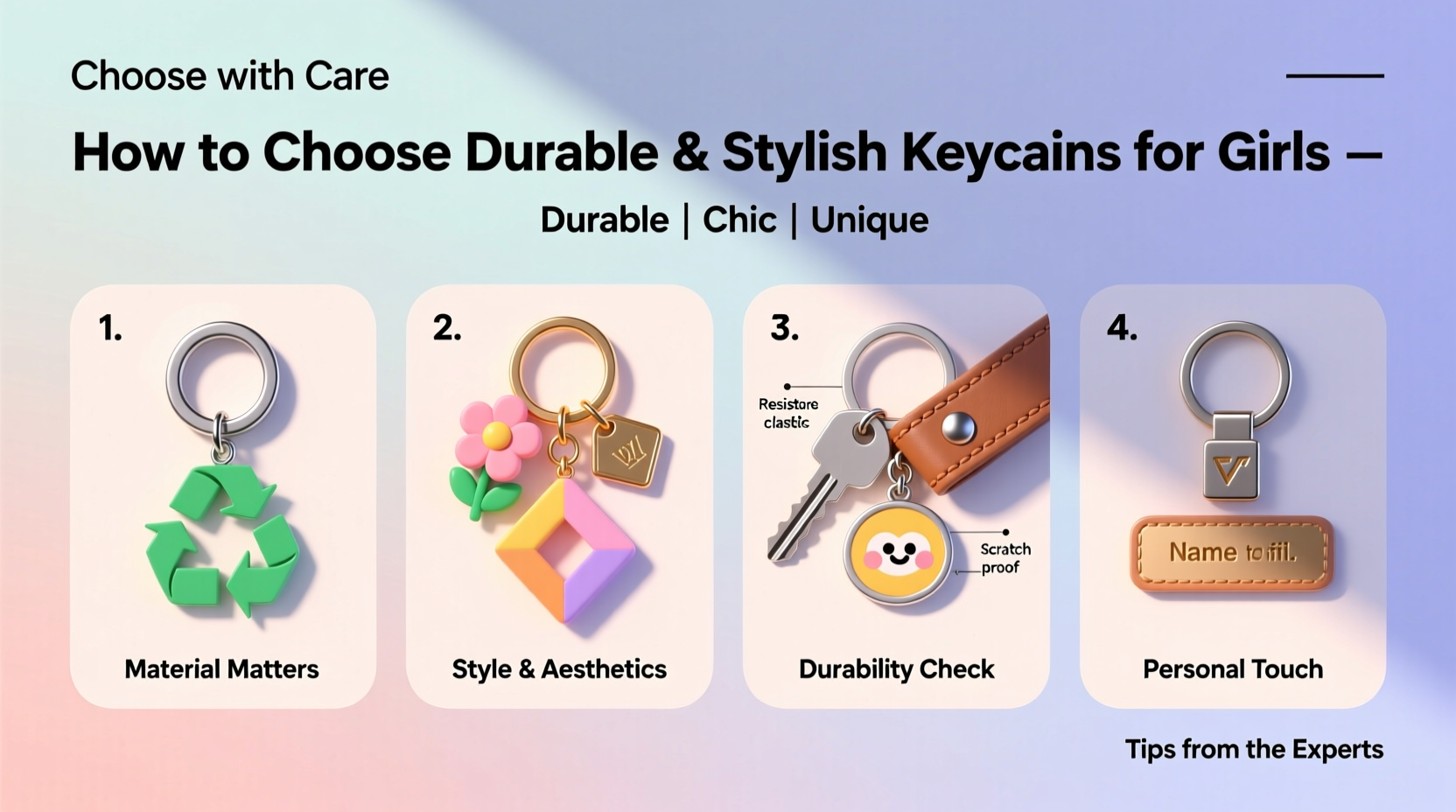Selecting the perfect keychain goes beyond aesthetics. For girls and young women who rely on their keys daily, a well-chosen keychain should be both functional and fashionable. Whether it’s a gift or a personal purchase, the right keychain combines durability, charm, and thoughtful design. With so many options—from minimalist metal tags to plush charms—it's easy to prioritize style over substance. However, long-term satisfaction comes from balancing both.
This guide breaks down the essential factors in choosing a keychain that lasts, performs well, and reflects individual taste. From material quality to attachment mechanisms and design versatility, each element plays a role in ensuring your keychain remains secure, stylish, and intact through daily use.
Understand Keychain Materials and Their Longevity

The foundation of any durable keychain lies in its materials. Different substances offer varying levels of resilience, weight, and visual appeal. Knowing what each material brings to the table helps avoid premature wear or breakage.
- Stainless Steel: Resistant to rust, corrosion, and scratches. Ideal for everyday carry, especially in humid environments.
- Aluminum: Lightweight and corrosion-resistant but less scratch-proof than steel. Often anodized for color without compromising integrity.
- Silicone: Flexible and impact-resistant. Great for active lifestyles, though prone to tearing if low-quality.
- Leather: Adds elegance and soft texture. High-quality full-grain leather ages beautifully; bonded leather may peel over time.
- Acrylic/Resin: Offers vibrant colors and custom designs. Durable if thick enough, but can crack under heavy impact.
- Fabric & Plush: Popular for decorative appeal. Best paired with a strong metal clip or used as an accent rather than the primary attachment.
Evaluate Attachment Mechanisms for Security
No matter how beautiful a keychain is, it’s useless if it detaches easily. The weakest link is usually the connector, not the charm itself. Common types include:
| Type | Pros | Cons |
|---|---|---|
| O-Ring (Split Ring) | Inexpensive, widely compatible, holds multiple keys | Can snag fabric; harder to load/unload keys |
| Carabiner Clip | Quick access, modern look, sturdy when made from steel | Bulkier; may open accidentally if low-quality |
| Trigger Clip | Smooth action, secure latch, sleek profile | More expensive; limited charm styles available |
| Keyring with Lobster Clasp | Elegant, secure, commonly used in jewelry-style chains | Smaller gate opening; not ideal for large key bundles |
For maximum security, look for keychains with welded joints and reinforced loops. A poorly soldered jump ring or thin clasp will fail within weeks under regular use.
“Most keychain failures happen at connection points. Always inspect the hardware—not just the charm.” — Daniel Reyes, Industrial Accessory Designer
Balance Style with Practicality
Girls often gravitate toward cute, personalized, or trendy keychains—think animal shapes, initials, enamel flowers, or pop culture icons. While these add personality, oversized or loosely assembled charms increase the risk of damage or loss.
A stylish yet practical keychain considers:
- Size-to-weight ratio: Bulky charms make pockets uncomfortable and strain attachments.
- Mobility: Excessive dangling parts can catch on bags or clothing.
- Personalization: Engraved initials or meaningful symbols enhance emotional value without sacrificing form.
- Versatility: Neutral tones or classic shapes transition better across seasons and outfits.
Mini Case Study: Emma’s Lost Keychain Habit
Emma, a college sophomore, went through three keychains in six months. Each was adorable—a glittery star, a plush cat, and a tassel with beads—but all broke within weeks. The star’s enamel chipped when dropped, the plush tore in her backpack, and the tassel unraveled after washing jeans with keys still attached.
After switching to a compact stainless steel disc engraved with her initials and attached via a trigger clip, she hasn’t lost or damaged it in over a year. “It’s simple,” she says, “but I actually notice it every day because it works so well.” Her experience highlights how emotional appeal must align with engineering for lasting satisfaction.
Step-by-Step Guide to Choosing the Right Keychain
Follow this five-step process to make a confident, informed decision:
- Assess Usage Needs: Is it mainly decorative? Used daily? Carried in a bag or pocket?
- Prioritize Material Quality: Opt for solid metals, thick silicone, or genuine leather over flimsy plastics.
- Inspect Hardware: Check that clips, rings, and connectors are seamless and tight-fitting.
- Test Proportions: Hold it against a standard house key—does it feel balanced or top-heavy?
- Verify Care Requirements: Can it withstand moisture, friction, and cleaning? Avoid glued elements near water exposure.
Checklist Before You Buy
Use this quick checklist to evaluate any potential purchase:
- ✅ Are all connections securely fastened?
- ✅ Does the material resist scratches and tarnishing?
- ✅ Is the size appropriate for daily carry?
- ✅ Can it be cleaned easily (e.g., wiped with a damp cloth)?
- ✅ Does it reflect the user’s style without being overly fragile?
- ✅ Is branding or engraving done cleanly and permanently?
Frequently Asked Questions
Are personalized keychains worth it?
Yes—if done right. Laser engraving on metal or high-quality resin ensures longevity. Avoid printed labels or stickers, which fade quickly. Personal touches increase attachment and reduce the chance of misplacing keys.
How do I clean a dirty keychain?
For metal: Use a soft cloth with mild soapy water, then dry immediately. For silicone or rubber: Wipe with a disinfectant wipe or rinse under warm water. Fabric charms should be spot-cleaned only—never soaked.
What’s the best keychain for teens?
Teens benefit from a mix of fun and function. Consider interchangeable charm systems (like charm bracelets adapted for keys) or customizable metal tags with playful fonts. Durability matters more than expected—teens tend to toss bags around, so reinforce hardware choices.
Final Thoughts: Style Meets Substance
The most memorable accessories aren't just eye-catching—they’re reliable. A well-chosen keychain becomes a trusted companion, reflecting identity while standing up to daily demands. By focusing on material integrity, smart design, and secure construction, you ensure that style doesn’t come at the cost of performance.









 浙公网安备
33010002000092号
浙公网安备
33010002000092号 浙B2-20120091-4
浙B2-20120091-4
Comments
No comments yet. Why don't you start the discussion?